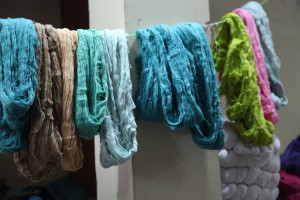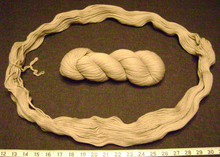When yarn or twine is coiled for dying or wrapped for selling it is done so by a set length and description – hank, ball, cone, bobbin, spool, cop etc.
The lengths might look random but they are standardised, or at least known. For example, in hand dying small quantities the dyer needs to know exactly how much has been dyed in order to plan for it’s sale and use.
As a general industry measure, we expect linen to be 300 yards – 270 metres and cotton or silk around 800 yards – 770 metres.
Again with hand dying the lengths can be specific to the dye shop by the amount of dye, the size of pot etc. the dyer uses.
Hanks and skeins are often less expensive to buy than rolls or balls – but for crochet and knitting the yarn only works in practice when it comes from a ball. The back of a chair or the outstretched arms of a small child who will stand still for 2 minutes ( yes that was me… and my siblings ) are perfect – the hank just needs to be held still whilst the knitter rolls it into a ball.


